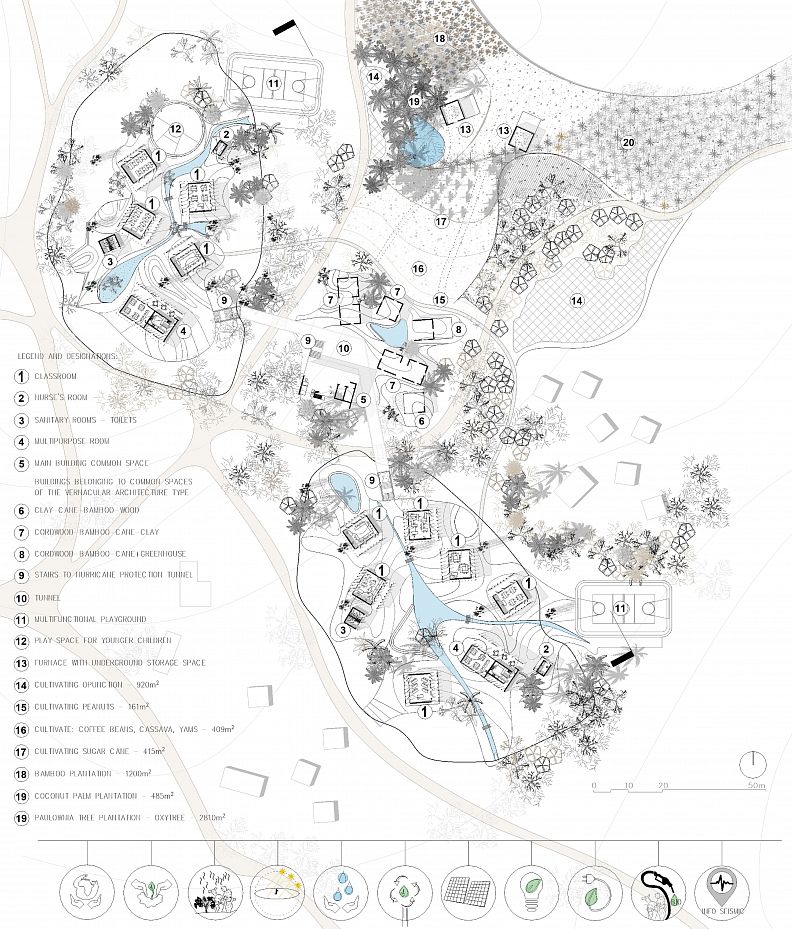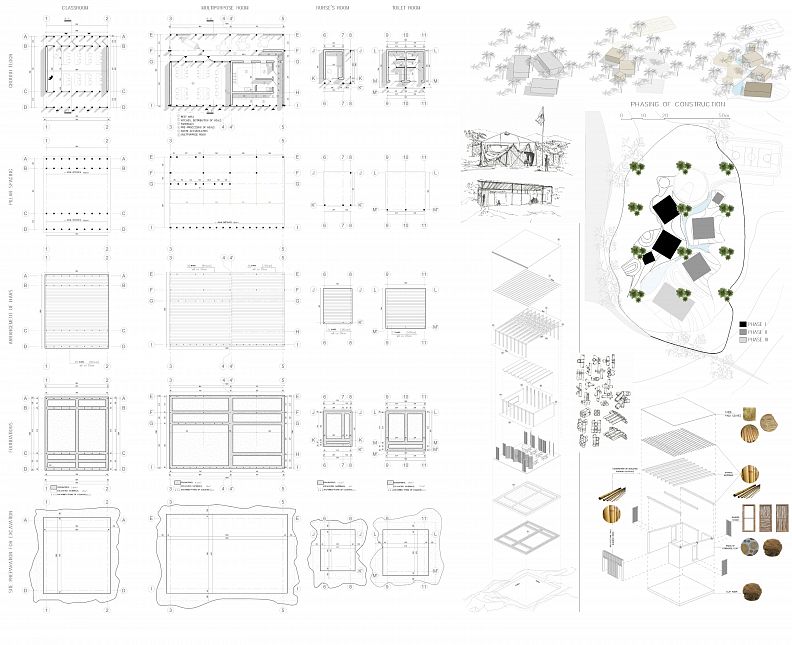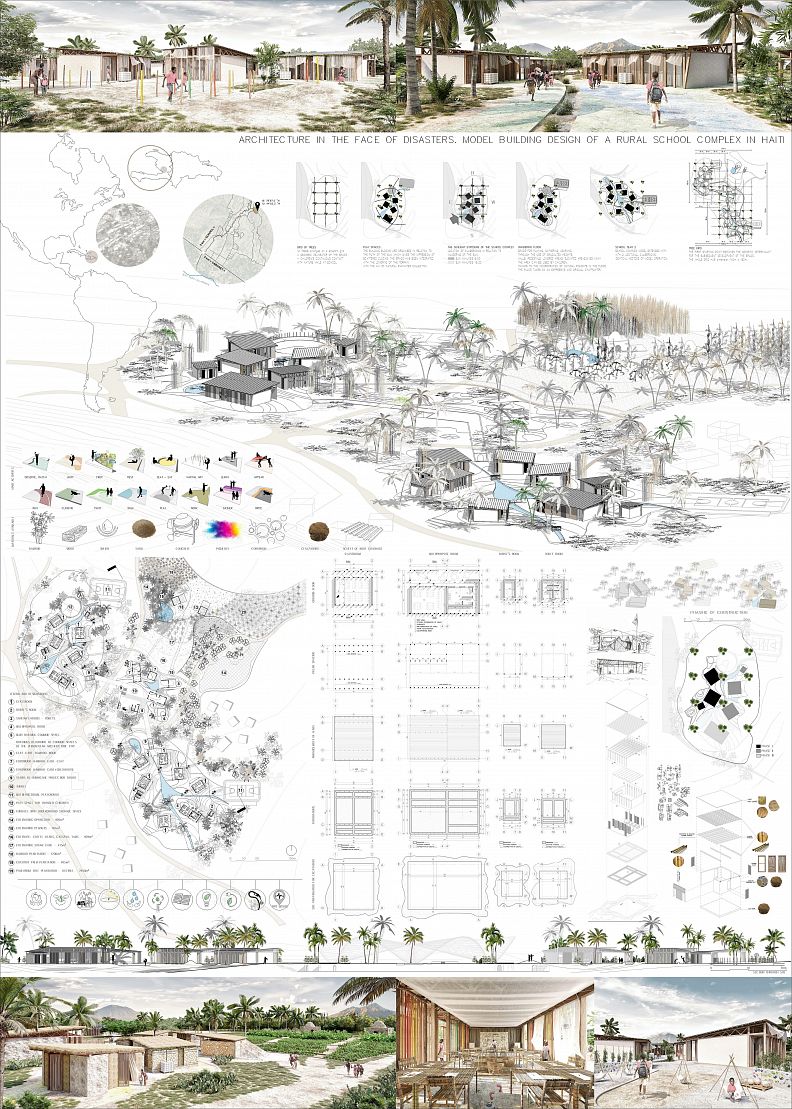ARCHITECTURE IN THE FACE OF DISASTERS. MODEL BUILDING DESIGN OF A RURAL SCHOOL COMPLEX IN HAITI

Project idea
INTRODUCTION: Communities affected by disasters lose homes, schools, and jobs in an instant. Rebuilding can take years. In the face of disaster, properly shaped architecture can become a helpful solution, offering a chance to recover from the crisis. Haiti, among others, became a field of experience for architecture in the face of disaster. Huge material losses have been noted so far on every level of social activity. The mentioned cataclysm has affected education and contemporary teaching model to a very large extent.
OBJECTIVE: The aim of this thesis is to present a way of model formation of a rural school complex on the example of Haiti. It can become a solution for implementation in areas with difficult conditions in the equatorial climate zone and areas prone to natural disasters. It also aims to develop practical possibilities of constructing natural buildings adapted to the region, in the context of material availability. The work tries to answer the question how to find and combine the architectural elements of space, ways of constructing buildings, availability of materials and the mentality of communities in the face of a disaster?
Project description
SUBJECT, SCOPE OF RESEARCH: The subject of this work becomes the model of the rural school building complex and its location. In order to achieve the objectives, the local conditions were analyzed in the context of developing the simplest and low-cost form of the building. The study area is the site of an existing temporary school on the island of Haiti and land located in the equatorial climate zone. The designed school complex includes 7 grade levels and will benefit over 50 children in a communal space that brings together the local community. It is planned to create 2 model village housing complexes.
RESEARCH PROBLEM: The research problem is to find a simple architectural form, blending it into the surrounding landscape as well as solutions on how to construct the buildings, availability of materials in the face of disaster and to show the possibility of model buildings.
ASSUMPTIONS: The main assumptions for the design work of model shaping of rural school complex are technical and social aspects. Paying attention to the use of simple technologies applicable according to the needs in equatorial climate (and not only), but also other disaster-prone areas/places /quick response in the post-crisis moment.
ASPECTS:
TECHNICAL ASPECTS
- quality of architecture
- sustainable architecture
- quality of construction
SOCIAL ASPECTS
- accessibility for children
- local community
- budget and phasing
Technical information
FUNCTIONAL SOLUTIONS: Model of rural school complex was estimated to minimum required surface, rooms and spaces according to determined criteria. The idea of phasing the assumption into 4 realization phases gives the possibility of efficient realization, within the framework of obtained materials and other necessary means. It was assumed that each phase will be independent from the next one and will not influence the already realized one. The first phase will include the construction of elements necessary for the functioning of the school: 2 classrooms, sanitary facilities - toilets and a nursing room. The second phase will increase the capacity of the school while improving its quality. This phase proposes the construction of 2 more classrooms and a multi-purpose room combined with a food preparation and consumption area. The third phase includes the development of the surroundings of the school complex buildings in accordance with the designated program and the introduction of self-sustainable solutions. The process of building the second school complex depends on the needs of the community in connection with the demand for education at different age levels. Creation of the new complex should be carried out according to the adopted scheme of shaping the development. The fourth phase is also independent. It is proposed to create a space for the local community and children, with a focus on producing local, home-grown produce. The buildings in this phase are grown materials (Paulownia-oxytree wood, bamboo, coconut, cane) combined with clay - as a naturally occurring sedimentary rock.
COMPOSITIONAL SOLUTIONS: The shaping of the model building of the rural school complex is based on the possibility of free building in a simple repetitive module. The main determinant of the scheme is a uniform arrangement of trees. The location context of the buildings is closely related to the introduced tree grid and the analysis of the sun's migration and the site conditions. The selected tree grid must be continued in the context of the entire site. The starting point becomes the geodetic determinant for the subsequent development of the space. By shaping the floor, children have the opportunity to choose activities and use them in ways that suit them. Surplus material excavated under the faults of the elements in the field, was reused to build and form steps, walls, and other elevations of the floor. The color in the floor is created by mixing the building material (clay) with admixtures of other rocks and components in combination with water, sand, concrete, natural pigments (marl, stoneware, limestone coral, conglomerate of volcanic rocks). The color reference is a reference to traditional Haitian painting, saturated with color. In addition to the aforementioned possibilities, the floor also offers to improve the microclimate of the place (bioclimatic aspect). The carved depression will accumulate water during the rainy season, resulting in better drainage from the topsoil to other areas outside the school buildings. On the other hand, during the dry season, the created water trough can be filled with harvested rainwater collected from the designed underground and aboveground tanks. The accumulation of waste generated during the life process of the school, is done by underground storage. The non-utilized parts of the plants, discarded after the collection of crops are stored in a designated composting area, from which it is planned to create biofuel. This process allows the team to operate continuously with profit. Additionally, 2 clay ovens have been set up on the hills of the cultivation site to process and dry the grown materials. A short distance from the kiln, underground cavities were located in the ground to store the crops harvested. By reusing the natural temperature of the earth below the surface, environmental impacts are reduced. All activities related to the creation of the model development of the rural school complex, are aimed at reducing the impact on the environment, land and water conditions and air pollution. The main intention is to minimize the disturbance of ecological characteristics of the land surface, soils and to preserve and increase the biologically active area. An important element of the development is also the creation of a hurricane protection tunnel between the school complexes. The construction of the school complex is characterized by simple and natural materials and those that have been grown through the implementation of crops: clay, structural wood - available for example mahogany, bamboo, sugar cane, coconut proper, coconut palm - Oxytree, prickly pear, cordwood technology - a combination of wood and clay.
SUMMARY: How architecture responds in the face of disasters is one of the of the most difficult architectural challenges. Decisions on response sites should go hand in hand with sustainable design and also with quality of architecture and construction, proper phasing and limited budget. The use of the basics of vernacular architecture consistent with local building construction techniques, the presence of natural materials for construction (clay, sand, bamboo, wood, water) allowed to achieve modularity not only the implementation in the equatorial climate zone, but also in the threatened rapid emergency response regions. The combination of the proposed simple technologies (cordwood, water collection, seismic warning, solar and water use, crops, biofuel) with the modularity of the built environment has a very positive environmental impact, with a virtually zero carbon footprint. The modularity of the built space is characterized by high mobility and self-sufficiency, which does not degrade the biologically active space. It also provides the opportunity for rapid arrangement and creation of custom structures typical of crisis solutions, also in the context of small residential houses (micro-homes). Architects will not win against nature, but they can try to learn from its vitality so as to create buildings and cities that can be reborn after a disaster in accordance with local conditions, material availability, social consciousness, and culture. Regenerative design goes beyond sustainability and talks about objects as active elements of the natural environment with a social context.

















